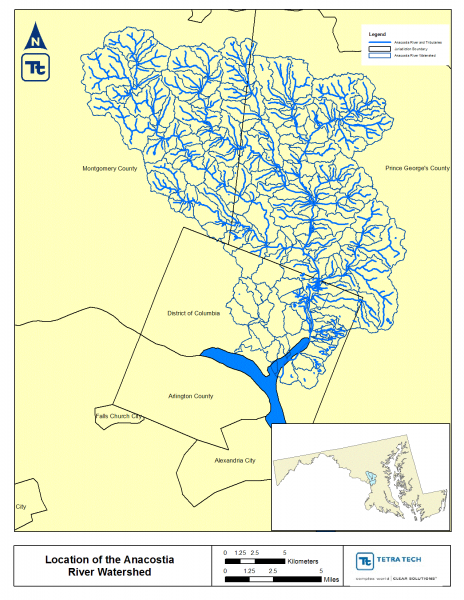The U.S. Environmental Protection Agency (EPA) is seeking readily available data and information on debris/floatables/trash (hereafter referred to as “trash”) in the Anacostia River watershed (Figure 1) for use in the development of a total maximum daily load (TMDL). The Anacostia River watershed covers portions of the District of Columbia and Prince George’s and Montgomery Counties in Maryland.

Figure 1: Location of the Anacostia River Watershed
A TMDL is an estimate of the maximum amount of a pollutant that a waterbody can assimilate without violating water quality standards. This total load includes pollutants that come from end-of-pipe dischargers, stormwater runoff, surface runoff from non-permitted areas (i.e. agriculture, open areas, forest, etc.), as well as a “margin of safety”, which accounts for uncertainties in the estimated load. TMDLs are important because they provide a framework to achieve water quality standards in a watershed. TMDLs inform other federal and state programs of the necessary pollutant reductions needed by source to achieve water quality standards.
On September 21, 2010, EPA approved a trash TMDL for the Anacostia River submitted jointly by the Maryland Department of the Environment (MDE) and the District Department of Energy and Environment (DOEE). On September 19, 2016, the Natural Resources Defense Council (NRDC) filed suit in the U.S. District Court for the District of Columbia seeking vacatur of EPA’s approval [Civil Action No. 16-1861 (JDB)]. The Court ruled in favor of NRDC on March 30, 2018 and directed EPA to develop or approve replacement TMDLs. In light of the Court’s Order, EPA is working with MDE and DOEE to determine the appropriate direction to take with developing new or revised TMDLs. An evaluation of data that has become available since approval of the original TMDLs will provide valuable insights into this determination.
EPA would appreciate your assistance in obtaining all readily available data and other information that would benefit the development of TMDLs for trash impairments in the Anacostia River watershed (Figure 1). Please consider these points in responding to this solicitation:
- EPA seeks any studies, surveys or other statistically significant information on the quantities of trash that would interfere with the general population’s use and enjoyment of the river for purposes such as swimming, boating and fishing. This data call is not intended as a user survey, and accordingly, EPA is not seeking the subjective views of individuals at this time.
- EPA is interested in documents or datasets that provide information regarding water quality conditions and sources associated with quantities of trash in the water. Potentially relevant data sources include: trash monitoring data, trash clean-up data, trash remediation project data, municipal separate storm sewer system (MS4) annual reports, etc. EPA is also interested in any other information data providers believe might be relevant.
- Trash data can be accounted for through measurements of weight, volume, count, or other appropriate measure. While EPA acknowledges that photographs may document the presence of trash, photographs are less useful for quantifying trash. Accordingly, EPA discourages submission of photographs as a method of quantifying trash extent and impairment.
- Please limit data submissions to only the waterbodies shown in Figure 1 for the period of August 2009 through present. If data collection efforts are currently underway, EPA would also appreciate an accounting of what is being collected and when it may become publicly available.
- EPA would prefer data and reports to be delivered in electronic format, as available. Specifically, datasets in Excel or a compatible spreadsheet format will facilitate ease of use.
- Information regarding sampling methodologies, design, conditions (i.e., time of day, weather conditions during and preceding the sampling), sampling locations (i.e., geographical coordinates, maps), peer review, and quality assurance procedures applied would also be very beneficial. Please include such information and citations where available.
- Please include names, contacts, and affiliations with your data submission.
Please submit data by October 23, 2018 to Jillian Adair, Water Protection Division (3WP30), U.S. Environmental Protection Agency Region 3, 1650 Arch Street, Philadelphia, PA 19103-2029, or emailed to [email protected].
Please note that EPA’s e-mail size limit is 25 Megabytes including e-mail text, all attachments, etc. Also, EPA is unable to receive .zip files, so please convert .zip files to .zzz or another data extension.
EPA appreciates your support in this endeavor. For additional information regarding this data solicitation, please contact Jillian Adair at 215-814-5713 or [email protected].

